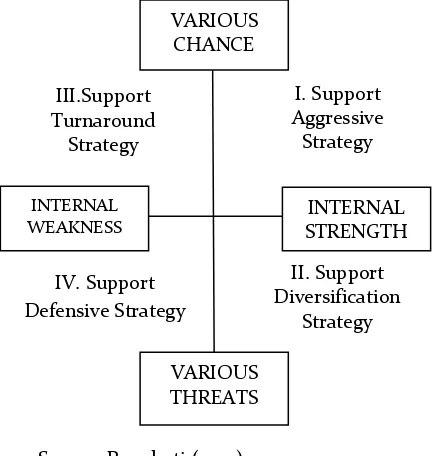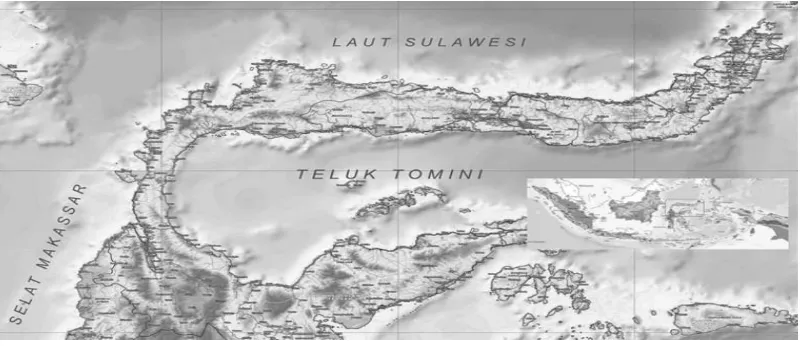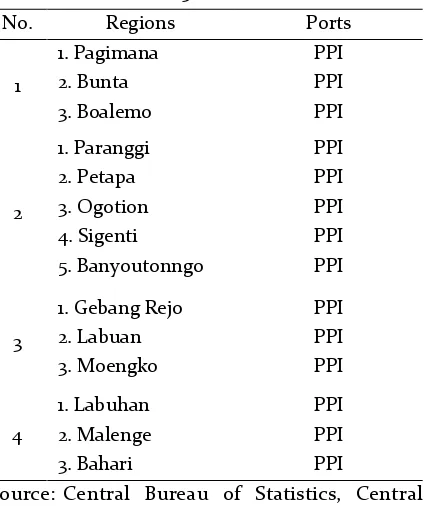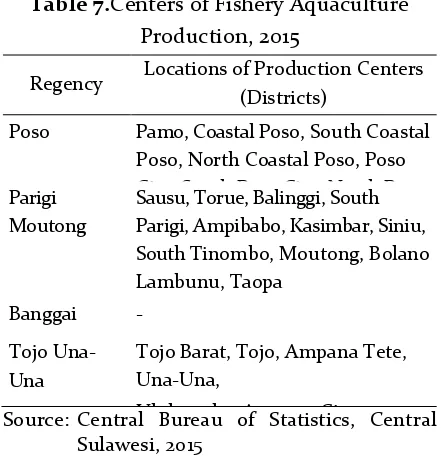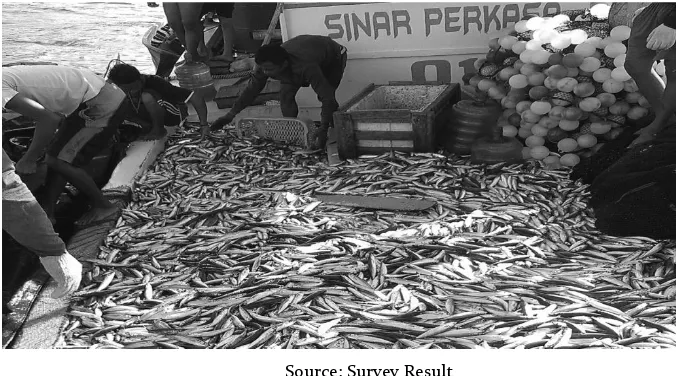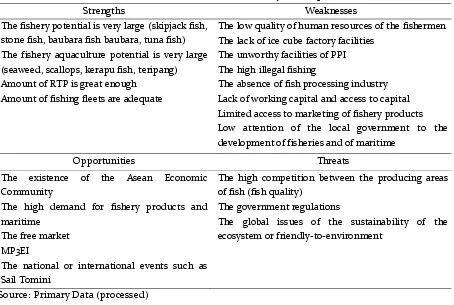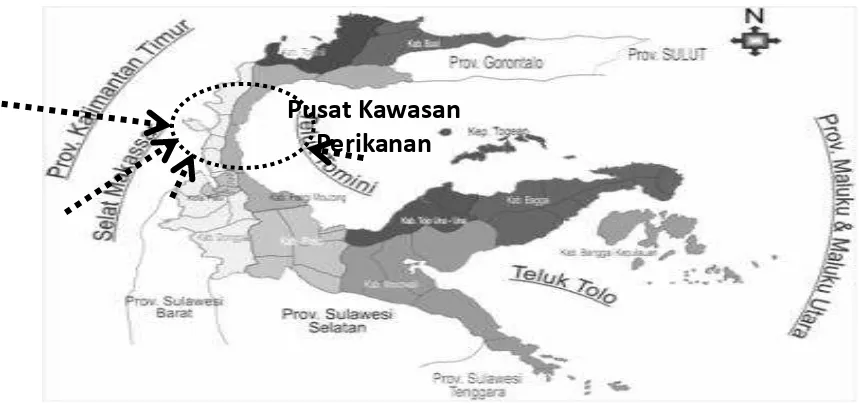JEJAK
Journal of Economics and Policy http://journal.unnes.ac.id/nju/index.php/jejak
Strategy of Developing Tomini Bay
for Economic Growth of Coastal Community
in Central Sulawesi
Muzakir1, Suparman2
1Tadulako University, Indonesia
Permalink/DOI: http://dx.doi.org/10.15294/jejak.v9i1.7189
Received: January 2016; Accepted: February 2016; Published: March 2016
Abstract
This research aims to analyze the potential and the strategy of developing Tomini Bay to improve the economic growth of the coastal community in Central Sulawesi. The research is located in four regencies in Central Sulawesi. The method uses the descriptive analysis using SWOT analysis. The research result shows that the potential of fisheries resources in Poso Regency, Parigi Moutong Regency, Tojo Una-Una Regency, and Banggai Regency can support the development of Tomini Bay region based on fisheries in order to accelerate the economic growth of coastal communities in Central Sulawesi. The potential fishery resources that can support the development of Tomini Bay area are the potential of fisheries, marine and coastal infrastructure, social economy and geographic conditions in four regencies. The strategies are building the marketing network for fishery products both the catching and cultivation, improving the fishery human resouce capacity, controlling the fishery product quality, and increasing the social awareness to maintain the ecosystem sustainability. To optimize the utilization of Tomini Bay, it is suggested to improve the involvement of the regional government, the central government, and also the private sector and the whole community.
Keywords: Tomini Bay, Economic Growth, Coastal Community, Central Sulawesi.
How to Cite: Muzakir, M., & Suparman, S. (2016). Strategy of Developing Tomini Bay for Economic Growth of Coastal Community in Central Sulawesi. JEJAK: Jurnal Ekonomi Dan Kebijakan, 9(1), 96-110. doi:http://dx.doi.org/10.15294/jejak.v9i1.7189
© 2016 Semarang State University. All rights reserved
Corresponding author : ISSN 1979-715X
INTRODUCTION
The coastal resources play an important role in supporting the regional and national economic development to increase the foreign exchange revenues, the employment, and the social income. The coastal resource has a comparative advantage because it is available in large quantities and diverse and can be used with a relatively inexpensive cost of exploitation so as to create a competitive demand capacity (Dahuri, 2001). The integrated coastal zone management as a dynamic and continuous process in making the decisions on the utilization, development and protection of the coastal areas and the oceans and their natural resources in a sustainable manner (Cicin- Sain and Knecht, 1998).
The development of the fishery sector in Indonesia is supported by the potential resources and the increasing market demands. The national economic policy oriented on the democratic economy based on fisheries needs to be developed to increase the employment and the economic growth level. The success in the fishery sector development finally has a positive impact for the development of the upstream
and downstream fishery industry.
Kusumastanto (2003) suggested that the development of sustainable fisheries is an activity of fishery resource management and its environment to meet the present-day needs without reducing the ability of the future generations to meet their daily needs.
Nasution (1999) suggested that the strategies of increasing the competitiveness of the fishery sector in order to enter the era of global markets are as follows: through the restructuring of the fishery economy in a broad sense, the increase in investment, structuring linkages with other sectors, and
promoting the participation of government and private. According to Balgos (2005), one of the main purposes of community-based
coastal resource management is the
empowerment of the disadvantaged nities, covering most of the coastal commu-nity and often affected various management issues.
Fernandes et al. (2014) suggested that the socio-economic data is very important for Philippines (96.96). Furthermore Pereto-mode (2014) found that the development of the maritime industry can reduce the unemployment and can strengthen the nation's economy.
Tomini Bay is the greatest bay in the
equatorial region with an area of 59,500 km2
or ± 6 million hectares, with very large potential natural resources. Tomini Bay in the East borders on the Maluku Sea, while in the Northeast borders on the Sulawesi Sea. In the distribution area of biodiversity, this area is in the zone of Wallacea, which historically is a separate region of the Asia and Australia Continents. Tomini Bay administratively covers three provinces and fifteen regencies / cities in Sulawesi corridor.
marine tourism with the beaches and oceans that can be developed as a prospective maritime tourism region for the develop-ment of regional and international coope-ration and also as the Gateway of Mina Bahari in the Pacific. Besides, it also has the potentials as a transportation line, mineral resources, or non-biological resources that have not been utilized optimally. Tomini Bay area is also a high priority to the resettle-ment site, economy, tourism, military, transportation, and industry. The high-use activities in the upstream and downstream areas around Tomini Bay need to be integrated and continuously maintained between the center and regions, including the stakeholders in preventing any damage to the environment, with the steps and concrete actions in the controlling.
Furthermore, there is an underwater natural beauty within the Tomini Bay that is very well known that seems to be a paradise for the divers. Besides its beautiful coral reefs, various fish species also live here. The assets of coastal and marine resources of Tomini Bay such as coral reefs are the parts of the world's Coral Triangle and the Marine National Park of Togean Island known as "the Heart of Coral Triangle". Togean Island attracts the international attention because it is a part of the important coral reef ecosystem of the 'Coral Triangle' with the highest coral diversity in the world, covering areas of Indonesia, Philippines, Malaysia, Papua New Guinea, until Microneasia.
The ecosystem of Tomini Bay as one of 26 national marine leading areas has the potential of coastal and marine resources that are very abundant for the development of the nautical tourism and the national food. Tomini Bay area includes the ecosystem of coral reefs, seagrass beds and
mangrove and coastal tourism and sea ports. Based on the potentials, in 2003 the Central Government has launched Tomini Bay area as a gateway of Mina Bahari and in 2008 has made the launch of the Accelerated Development Program of Tomini Area by the Minister for Regional Acceleration.
Besides, the very strategic location makes Tomini have a potential as a bridging zone for the activities of sea transport linking the Central-North part of Sulawesi with ASEAN countries, the countries in the Pacific region, Australia and other regions in Indonesia. Therefore, the attention of the Government of Central Sulawesi Province related to the problems of pollution, environmental damage and socio-economy that will affect Tomini Bay requires handling together. Many areas of its territory enter or are interested in Tomini Bay, then on one side the area obtains a benefit from the ownership of the high potential of the marine and coastal resource enriched with quite large biodiversity, so this can be used management of all or any part of Tomini Bay areas.
actions so the damage that has begun to occur in the area can be handled imme-diately. UNESCO has also determined Tomini Bay as one of the wealth of world that should be protected. Because, in this bay there is a lot of marine potential that is very promising.
Tomini Bay has the abundant fishery potential, but the potential is inversely proprotional to the social welfare conditions in four regencies in Central Sulawesi Province (Parigi Moutong Regency, Poso Regency, Tojo Una-Una Regency, and Banggai Regency), especially the people in the coastal area of Tomini Bay. Central Sulawesi Province has the second highest poverty level after Gorontalo in Sulawesi corridor amounted to 13.61 per cent (Central Bureau of Statistics, Central Sulawesi, 2015), and generally the poor people live around the coastal area. It shows that the utilization of Tomini Bay is not optimal yet to improve the welfare of people around the area. Puspita (2015) suggested that poverty is a problem that is experienced by many countries around the world. Various efforts have been made, starting from the local fishery products in Central Sulawesi in order to accelerate the economic growth of the community, regional and national levels.
RESEARCH METHODS
This is a descriptive research, which describes in details the potential and strategy of developing Tomini Bay in the acceleration of economic growth in coastal communities in Central Sulawesi. This research uses the primary and secondary data. The primary data is obtained from the direct observation in the research location in the form of fishery potential of Tomini Bay, while the secondary data is the supporting data obtained from the Regional Development Planning Agency and the Central Bureau of Statistics, Central Sulawesi Province.
The strategy of developing Tomini Bay uses SWOT analysis. The SWOT analysis is to identify the various factors systematically to formulate the strategy. This analysis is based on the logic that maximizes the chances but simultaneously minimize the disadvantages and threats. The SWOT analysis compares the external and internal factors (Rangkuti, 2010). The SWOT analysis diagram is as follows:
Source: Rangkuti (2010)
RESULTS AND DISCUSSION
Tomini Bay area includes four regencies in Central Sulawesi Province those are Parigi Moutong Regency, Poso Regency, Tojo Una-Una Regency, and Banggai Regency. The Central Sulawesi Province is located between 2o22' North Latitude - 3o48' South Latitude
and 119o22' East Longitude - 124o22' East
Longitude with a land area width of about
68033.00 km2. The Northern part of Central
Sulawesi Province is bounded by the Sulawesi Sea and Gorontalo Province, the Eastern part borders to Maluku Province, the Southern part borders to West Sulawesi Province and Southeast Sulawesi Province, and the Western part borders to the Makassar Strait.
Tomini Bay, like other regions in Indonesia, has two seasons, dry and rainy. This situation is closely related to the wind directions in this area, in which from October until March it usually rains because it is influenced by the winds blowing from the West / Northwest that contain a lot of water, while from May until September the dry season usually occurs because it is influenced by the wind direction from the East that contains no much water.
The temperature in a place is determined by throughout the year of 2013, in which the
lowest average air temperature of 26.60C
occurred in July and September, while the
highest of 28.50C occurred in March. Most
wind directions during 2013 are from the Southwest position, with an average speed of 3.6 knots. The rainfall in Central Sulawesi Province varies each month. The highest average rainfall during the year of 2013 occurred in April about 62.33 mm, while in September the rainfall experienced a low point of only 10.44 mm.In April people have the most rainy days of 21 days.
The wind state in Central Sulawesi Province monitored from Mutiara Palu Meteorological Station shows that the average wind speed ranges from 4.4 to 6.0 knots. The highest wind speed occured in September (6.0 knots) and the lowest one occurred in July (4.0 knots). The air humidity was recorded as 76.40%. Nevertheless, the temperature is also influenced by altitude above the sea level. The higher the location is, the lower the temperature will be, with the calculation that each increment of 100 meters can lower the temperature around 0,6oC.
The unique ecosystems are found in the coastal and tropical marine areas, especially the coral reefs in Tomini Bay area. The coral reef ecosystem has the multi-function characters; besides as a habitat for many types of biota, this ecosystem also functions as the bio-resources, a source of beauty and physical protector of the island. This ecosystem is a seabed ecosystem of tropical marine which communities are dominated by the marine biota producing the lime, especially the stony corals and the calcareous algae. One of the coral reef ecosystems in Tomini Bay can be found along the area of Parigi Moutong Regency and some other also can be found in the areas of Poso Regency, coral reefs in Parigi Moutong Regency can be found in Ampibabo, Parigi, and Sausu follows: bad (42.86%), medium (42.86%) and good (14.28%). The percentage is as follows: 7.5% of soft coral cover, 24% of dead coral, and 0.92% of diversity 0.92 (productive). There are 19-27 of the genus and the dominant coral species are Acropora and Porites. Such conditions indicate that the component of living coral is still higher than the dead coral on the reef ecosystem classified as the productive one. Some
identified factors that influence the
condition of coral reefs are mining, bombs and sedimentation.
The coral reefs in Parigi District can be found in the regions of Toboli, Marantale, Parigi, and Lebo. The percentage of the coral covers ranges between 10% - 73% with an coral, and 1.03 of diversity (very productive). There are 19 types of genera and the
dominant species is Acropora. Such
conditions indicate that the component of the living coral is still higher than the dead coral on the coral reef ecosystem classified as the productive one. Some identified factors that influence the condition of the coral reefs are mining, bombs, and sedimentation.
immediately conduct a management ac-tion to rehabilitate/restore the condiac-tion of the coral reefs. Some identified factors that influence the condition of the coral reefs are mining, bombs, and sedimentation.
Based on the above results, in general, the condition of the coral reefs in Parigi Moutong Regency is as follows: 46.43% (bad), 32.14% (medium), 21.43% (good) and nothing included in the excellent category. These results indicate that the condition of the coral reefs in Parigi Moutong Regency coral reefs are as follows: catching the fish by using bombs and poisons, the coral mining for various purposes, and the sedimentation from land either through rivers or directly into the sea.
The Fishery Households (RTP) in Tomini Bay is as follows: without a boat (TP), a boat without a motor (PTM), a motorboat outboard (PMT) and a motor ship (KM). The highest number of RTP is found in Banggai Regency (7598 RTP). The number of RTP in Tomini Bay area is presented on Table 1.
The fishing fleet used by the fishermen in Tomini Bay area consists of a boat without a motor (PTM), a motorboat outboard (PMT), and a motor ship (KM). The number of the fishing fleet in Tomini Bay area is presented on Table. 2.
The fishing fleet in the coastal area of Tomini Bay in Poso Regency is spread over in five districts as follows: Coastal Poso, North Coastal Poso, Poso City, North Poso City, and Lage. The number of the fishing fleet based on its types in each district is as
follows: Coastal Poso (PTM 380 units; PMT 232 units; KM 2 units), North Coastal Poso (PTM 441 units; PMT 270 units; KM 1 unit), District, while of PMT and KM are in Poso City District.
Table 1. A Number of Fishery Households
(RTP) of Sea Fisheries in Coastal Area of Tomini Bay, 2015
No. Regency Fishing Fleet (RTP) TP PTM PMT KM Source: Central Bureau of Statistics, Central
Sulawesi, 2015.
Table 2. A Number of Fishing Fleet in Coastal Area of Tomini Bay,
A Year of 2015
No. Province / Regency Fishing Fleet (Unit) PTM PMT KM
Source: Central Bureau of Statistics, Central Sulawesi, 2015
The coastal area of Tomini Bay in the Parigi Moutong Regency is spread over in nineteen districts as follows: Sausu, Torue, Balinggi, Parigi, South Parigi, North Parigi,
Central Parigi, Ampibabo, Kasimbar,
Tomini, Mepanga, Palasa, Moutong, Taopa and Bolano. The number of the fishing fleet based on its type in each district is as follows: Sausu (PTM 45 units; PMT 83 Central Parigi (PTM 18 units; PMT 33 units; KM 5 units), Ampibabo (PTM 138 units; PMT 137 units; KM 6 units), Kasimbar (PTM 66 units; PMT 51 units), Toribulu (PTM 154 units; PMT 119 units), Siniu (PTM 155 units; PMT 112 units ; KM 1 unit), Tinombo (PTM 6 units; PMT 108 units; KM 5 units), Tinombo South (PTM 72 units; units; PMT 41 units) and Bolano (PTM 129 units; PMT 102 unit; KM 5 units). Thus, the most number of fishing fleets of PTM is in Tomini District, while of PMT and KM units; PMT 178 unit; KM 367unit), Bualemo (PTM 492 units; PMT 315 units; KM 140 units) and Lobu (PTM 187 units; PMT 185 units; KM 32 units). Thus, the most
number of the fishing fleet of PTM and KM are in Pagimana District, while of PMT is in Bualemo District.
The fishing fleet in the coastal area of Tomini Bay in Tojo Una-Una Regency is spread over in all districts as follows: West Tojo, Tojo, Ulubongka, Ampana Tete, Ampana City, Una-Una, Togean, Walea Islands, and the Great Walea. The number of the fishing fleet based on its type in each district is as follows: West Tojo (PTM 19 units; PMT 59 units), Tojo (PTM 36 units; PMT 95 units; KM 4 units), Ulubongka (PTM 36 units; PMT 97 units), Ampana Tete (PTM 48 units; PMT 49 units), Ampana City (PTM 11 units; PMT 237 units; KM 19 units), Una-Una (PTM 23 units; PMT 426 units), Togean (PTM 89 units; PMT 247 units ), Walea Islands (PTM 756 units; 637 PMT unit; KM 1 unit), Great Walea (PTM 41 units; PMT 133 units). Thus, the most number of fishing fleets of PMT and PTM is in Walea Islands District, while of KM is in Ampana City District.
The fishing devices generally used by the fishermen are the pulling trawl, the lifting trawl, the fishing rods, and the stretching nets. So it can be said that in general the people around Tomini Bay still use the traditional ways to conduct the fishing.
Besides the fishing fleet, the fishing devices used by the fishermen around the coastal area of Tomini Bay consists of various types, among others, are as follows in table 3.
Tomini Bay area include: Parigi, Ampana, Pagimana, Malingi, and Togean. The planning of construction and development of the fishing ports in Tomini Bay in 2010-2030 is presented in Table. 4.
Table 3. Types of Fishing Device Used by Fishermen in Coastal Area of Tomini Bay, Year of 2015
No. Types of Fishing Device
1 Fish Pulling Trawl
2 Single Shrimp Pulling Trawl 3 Framed Pulling Trawl 4 Payang 10 Other Lifting Nets
11 Raft Board Chart 18 Basic Regular Rawai 19 Huhate
29 Seaweed Collection Tool 30 Scalloop Collection Tool
31 Sea Cucumber Collection Tool 32 Crab Collection Tool
33 Muoroami
Source: Central Bureau of Statistics, Central Sulawesi, 2015
Besides the fishing ports (PPI), one of the facilities required for the development of marine capture fisheries is the ice cube factory. The ice cube factory is needed in the process of freezing the fish to be marketed in the form of fresh fish. The number of ice cube factories in Tomini Bay area are as follows:
Table 5. Ice Cube Factories, Tahun 2015
No Regency Amount Expl.
Source: Central Bureau of Statistics, Central Sulawesi, 2015
aquaculture (fish ponds) are the milkfish, the other fish, the black tiger shrimp, and the other shrimp. Types of commodities produced from the seawater aquaculture are the seaweed, kerapu, and the other fish. In
Parigi Moutong 196.105,7 651.759.013 Banggai 104.736,2 180.422.510 Tojo Una-Una 67.780,9 490.982.200
Total 370.812 1.355.379.007 Source: Central Bureau of Statistics, Central
Sulawesi, 2015
The seaweed aquaculture contributes most to the fishery aquaculture production amounted to 92.2 percent, while the rest are the fishery aquaculture of fish ponds, ponds, keramba, and floating nets respec-tively of 7.2 percent, 0.6 percent, 0.03 percent, 0.002 percent. Thus, the fishery aquaculture having a great potential to be developed is seaweed. Centers of fishery aquaculture production in Tomini Bay area are mainly in all of the districts in four regencies. Centers of fishery aquaculture production in Tomini Bay are presented in Table 7.
Tomini Bay area has the potential resources of great capture fishery. The number of production and production value of the capture fisheries in Tomini Bay is presented in Table. 8.
Table 7.Centers of Fishery Aquaculture Production, 2015
Regency Locations of Production Centers (Districts)
Poso Pamo, Coastal Poso, South Coastal Poso, North Coastal Poso, Poso City, South Poso City, North Poso Parigi
Tojo Barat, Tojo, Ampana Tete, Una-Una,
Ulubongka, Ampana City
Source: Central Bureau of Statistics, Central Sulawesi, 2015
Table 8.A Number of Production and Pro-duction Value of Marine Capture Fishery in Coastal Area of Tomini Bay, 2015
Regency Amount (ton)
Production Value (RP. 1000) Banggai 10.839,20 113.874.940 Poso 8.683,24 149.324.065 Parigi Moutong 23.460,38 278.320.012 Tojo Una-Una 8.509,14 88.651.020 Total 51.491,96 630.170.037 Source: Central Bureau of Statistics, Central
Sulawesi, 2015
44.64 tons are dried), North Parigi (1357.21 tons are marketed), Central Parigi (2185.59 tons are marketed), Ampibabo (3273.73 tons are marketed; 120.21 tons are dried; 224.37 tons are cured), Kasimbar (936.11 tons are marketed; 36.66 tons are dried), Toribulu (1202.55 tons are marketed; 46.68 tons are dried), Siniu (775,25 tons are marketed; 3.73 tons are dried; 2.20 tons are cured), Tinombo (901.63 tons are marketed), South Tinombo (941.60 tons are marketed; 258.60 tons are dried; 61.51 tons are cured), Tomini (924.87 tons are marketed; 359.29 tons are dried), Mepanga (266.83 tons are marketed), Palasa (550.68 tons are marketed), Moutong (1373.89 tons are marketed; 183.98 tons are dried), Taopa (285.11 tons are marketed; 4.58 tons are cured), and Bolano (2231.61 tons are
marketed; 1.03 tons are dried). This indicates that all this time the production of capture fisheries are fresh marketed (94%) and the rest (6%) are processed in the form of drying and curing.
The species of fish caught by the fishermen in Tomini Bay consist of pelagic fish, demersal fish, crustaceans and others. The species of pelagic fish commonly caught include bloated fish, kite fish, skipjack fish, tuna fish, and selar fish. The species of demersal fish commonly caught include tengiri fish, sharks and snapper fish. The species of crustaceans commonly caught include black tiger shrimp, prawn and other shrimps. The centers of marine capture fishery production in Tomini Bay are presented in the following table 9.
Table 9.Centers of Marine Capture Fishery Production in Coastal Area of Tomini Bay, 2015
No. Regency Location of Production Centers (District)
1. Poso Coastal Poso, North Coastal Poso, Poso City, North Poso City, Lage
2. Parigi Moutong Sausu, Torue, Balinggi, Parigi, South Parigi, North Parigi, Central Parigi, Ampibabo, Kasimbar, Toribulu, Siniu, Tinombo, South Tinombo, Tomini, Mepanga, Palasa, Moutong, Taopa, Bolano
3. Banggai Nuhon, Bunta, Pagimana, Bualemo, Lobu
4. Tojo Una-Una Tojo Barat, Tojo, Ulubongka, Ampana Tete, Ampana City, Una-Una, Togean, Walea Islands, Great Walea
Source:Central Bureau of Statistics, Central Sulawesi, 2015.
Source: Survey Result
Based on the analysis above, there are some strategic issues related to the development of capture fisheries and aquaculture in Tomini Bay area as follows in table 10.
Based on the potential of fisheries in Tomini Bay above, the strengths,
weak-nesses, opportunities and threats (SWOT) are formulated for the development of Tomini Bay for the acceleration of the economic growth in the coastal commu-nities in Central Sulawesi. The SWOT identification of Tomini Bay development is as follows in table 11.
Table 10.Strategic Issues on Fisheries in Coastal Area of Tomini Bay
Capture Fisheries
1. There is still the illegal fishing practice in Tomini Bay Area 2. The destructive fish capture damages the marine biodiversity 3. The value added result of fish capture has not been optimal
4. There is damage to the aquatic ecosystem along the coastal area Tomini Bay
5. The quality of human resources (HR) of fishermen reflecting their knowledge and skills in catching fish is still low
6. The mastery of technology by fishermen is still low
7. The market access is still weak due to the lack of control of market information
Fishery Aquaculture
1. The qualified seed for fishery aquaculture is still difficult to obtain
2. The ice disease often affects the seaweed aquaculture
3. The continuity of supplying the raw materials for the industry, the implementation of a quality management system are not in accordance with the standards, the agro-industry expected to provide the additional value to the potential commodities is not developed as expected
4. The post-harvest technology including the packaging has not been utilized adequately, the existing processing industry has not varied and has not been innovative
5. There is still the processing system that is not in accordance with the provisions of the quality standards
6. There are the lack of promotion intensity and the low participation of stakeholders in developing the promotional programs of value-added fishery products
7. The raw material for the fish industry has not been standardized because most of the fishery business are produced by the small-scaled fishermen
8. The types of products and the development of value-added products have not been optimally developed and has not been popular although the study and utilization of research results are widely available, but the mass production cannot be realized because of the availability of infrastructure, high cost of equipment, lack of technology and problems continuity of supplying raw materials
9. The quantity of waste that goes into the coastal and marine ecosystems in Tomini Bay any time continues to increase, the rivers flowing into the bay area are all functioning well as the industrial and domestic waste disposal, these rivers pass through many regions, and flow into coastal and marine areas
Table 11.SWOT Matrix of Tomini Bay Development
Strengths Weaknesses
The fishery potential is very large (skipjack fish, stone fish, baubara fish baubara, tuna fish) The fishery aquaculture potential is very large (seaweed, scallops, kerapu fish, teripang) Amount of RTP is great enough
Amount of fishing fleets are adequate
The low quality of human resources of the fishermen The lack of ice cube factory facilities
The unworthy facilities of PPI The high illegal fishing
The absence of fish processing industry Lack of working capital and access to capital Limited access to marketing of fishery products Low attention of the local government to the development of fisheries and of maritime
Opportunities Threats
The existence of the Asean Economic Community
The high demand for fishery products and maritime
The free market MP3EI
The national or international events such as Sail Tomini
The high competition between the producing areas of fish (fish quality)
The government regulations
The global issues of the sustainability of the ecosystem or friendly-to-environment
Source: Primary Data (processed)
Based on the identification of
strengths, weaknesses, opportunities and threats, there are some strategies that can be formulated by using the strengths to utilize the opportunities, using the strengths to solve the threats, streng-thening the weaknesses by utilizing the strengths and minimizing the weaknesses and overcoming the threats. The formu-lation of the development strategy of Tomini Bay is as follows in table 12.
The strategies are applied by involving all relevant parties, among others: the local government, the private sectors and the communities around Tomini Bay. The involvement of these parties will create a synergy to develop Tomini Bay as the fishery area to improve the social economy with regard to the sustainability of the ecosystem in Tomini Bay through the model of of fishery area development in
Tomini Bay in a sustainable manner. The model of fishery area development in Tomini Bay in a sustainable manner is as follows in figure 4.
Pusat Kawasan
Perikanan
Table 12.Matrix of Development Strategy of Tomini Bay Strategies of using the strengths to utilize the
opportunities
Strategies of strengthening the weaknesses and utilizing the opportunities
• Opening the product marketing network of capture fisheries and aquaculture
• Establishing the fish processing industry
• Establishing the seaweed processing industry
• Creating the marine fishery aquaculture areas, particularly seaweed
• Increasing the capacity of human resources in fishery
• Increasing the number of ice cube factories to meet the needs of ice blocks in Tomini Bay area
• Performing the maintenance and rehabilitation of PPI
• Conducting the law enforcement against the illegal fishing
• Providing the working capital facilities and the access to the capital
• Improving the partnership cooperation between the local government and the fishermen. Strategies of using the strengths to face the
threats
Strategies of minimizing the weaknesses and facing the threats
• Performing the quality control of the fishery products
• Creating the local regulations on fisheries for structuring Tomini Bay
• Controlling the waste and the use of fishing device that may damage the environment
• Making the quality standard of the fishery product
• Creating the network of fishery product marketing in domestic areas and foreign countries
• Increasing the public awareness of the importance of the sustainability of the ecosystem or friendly-to-environment
Source: Primary Data (processed)
Source: Primary and Secondary Data (processed)
CONCLUSION
Based on the above discussion, it can be concluded that the potential of fishery resources in Poso Regency, Parigi Moutong Regency, Tojo Una-Una Regency, and Bang-gai Regency can support the development of Tomini Bay fishery-based area in order to accelerate the economic growth of the coastal communities in Central Sulawesi.The potential fishery resources that can support the development of Tomini Bay area are the potential of fisheries, the marine and coastal infrastructure, the social economic, and the geographic conditions in four regencies. The strategies used are as follows: opening the network of capture fishery product and aquaculture, improving the human resource capacity in fisheries, performing the quality control of fishery products, and increasing the social awareness on the importance of the sustainability of the ecosystem or friendly-to-environment. In optimizing and sustainably utilizing the potential of Tomini Bay, it needs to involve the participations of the local government, the central govern-ment, the private sectors, and the society.
REFERENCES
Badan Pusat Statistik. (2015). Sulawesi Tengah Dalam Angka. Palu: Badan Pusat Statistik Provinsi Sulawesi Tengah.
Balgos, Miriam C. (2005). Integrated Coastal
Manage-ment and Marine Protected. Areas in the
Philipines: Concurrent Developments.
Cicin-Sain, B. & R. W. Knecht. (1998).Integrated Coastal And Ocean Management: Concepts And Practices. Island Press: Washington D. C.
Dahuri, R.(2001). Pengelolaan Sumberdaya Wilayah Pesisir Dan Lautan Secara Terpadu. PT. Pradnya Paramita , Jakarta.
Evers, Hans-Dieter, Azhari Karim (2011). The Maritime Potential of ASEAN Economies. Journal of Current Southeast Asian Affairs, 30, 1, 117-124.
Foley N. S, Escapa M., Fahy F. (2014). Developing a Comparative Marine Socio-Economic Framework for the European Atlantic Area. Journal of Ocean and Coastal Economic. December 2014.
Kusumastanto. (2003). Ocean Policy dalam Mem-bangun Negeri Bahari di Era Otonomi Daerah. Gramedia Pustaka Utama, Jakarta
Nasuition A. H. (1999). Perencanaan Dan Pengendalian Produksi, Guna Widya, Jakarta
Peretomode V. F. (2014). The Role of the Maritime Industry and Vocational and Technical Education and Training in the Economic Development of Nigeria. IOSR Journal Of Humanities And Social Science (IOSR-JHSS) Volume 19, Issue 5, Ver. V (May. 2014), PP 45-50 e-ISSN: 2279-0837, p-ISSN: 2279-0845.
Puspita, Dita Wahyu. (2015). Analisis Determinan Kemiskinan di Provinsi Jawa Tengah. Jurnal
Ekonomi dan Kebijakan (JEJAK) Volume 8, Nomor
1, Semarang-Maret 2015 hal 83-88.
